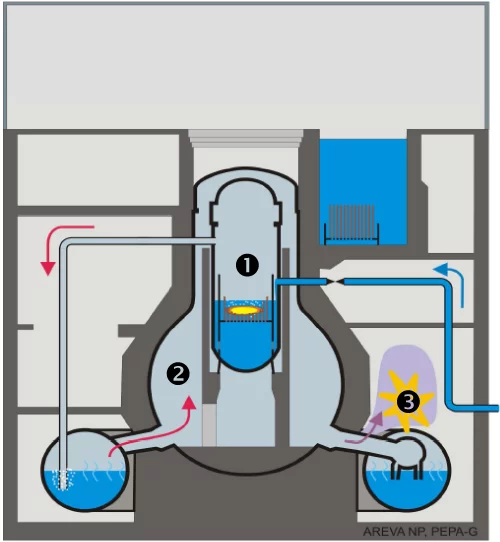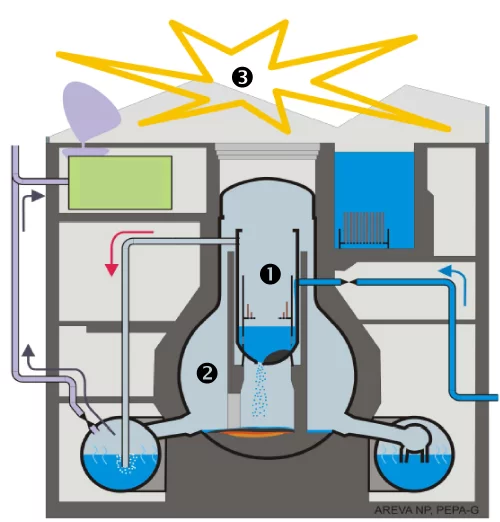Researchers at the Paul Scherrer Institute (PSI) are currently involved in an international project aimed at reconstructing what happened to the reactor units during the nuclear accident at the Japanese nuclear power station, Fukushima Daiichi in March 2011. In particular, the estimate of the core end-state shall help the owner of the damaged plant, the Tokyo Electricity Power Company (TEPCO) to plan the removal of components from the reactor containment and the final decontamination. Besides, the exercise is intended to contribute to further refinement of the computer programs used to perform nuclear accident simulations.
In March 2011 one of the biggest catastrophes in the history of the peaceful use of nuclear energy was triggered by an extremely strong earthquake and the subsequent tsunami on the eastern coast of the Japanese island Honshu. During the next days, devastation of the local area due to the flooding meant that vital power supplies were unavailable and other services were disrupted. During the accident, three units of the nuclear power station Fukushima Daiichi suffered extensive damage to the reactors and buildings. It is widely believed that all three reactor cores experienced some melting. As a consequence of the accident and the release of radioactive material a large area surrounding the accident site had to be evacuated and many of its inhabitants relocated away from their homes. The accident triggered a political aftermath, not only in Japan: governments of several countries worldwide, including Switzerland, decided to rethink their nuclear energy policies.
Decontamination still to be carried out
Although the destroyed plants were stabilised in the next weeks, TEPCO and their staff, faced a huge and challenging task to decontaminate the station, indeed this challenge remains today. In fact, one of the big difficulties is the current uncertainty about what the engineers will find waiting for them when they first enter the reactor containments. Depending on the state of the reactors, it may be necessary to use special equipment and measures for personnel protection. TEPCO therefore strongly need the best possible indication of the state of the reactors – how much of each core had melted down, and whether the melted material (known as “corium”) remains inside the steel reactor vessel or if, as was feared, it was ejected onto the floor the containment where it might have been causing further damage by eroding the concrete. The two contrasting outcomes are indicated schematically in figures 1 and 2.
The Organisation for Economic Cooperation and Development (OECD) launched in November 2012 an international project to advance the understanding of the phenomena of severe accident behaviour specific to the Fukushima Daiichi NPS accident with participants from institutes in several countries (France, Germany, Japan, Korea, Russia, Spain, Switzerland and USA). The essence of the exercise is that participants use state-of-the-art computer programmes which can simulate the processes that might take place during a nuclear accident, and hence calculate the sequence of events that occurred inside the reactor. Based on these calculations the scientists aim at reconstructing the end state after the first six days of emergency actions by the plant operators.
PSI scientists simulate events in reactor unit 3
The various participants are working separately and independently. The purpose of this way of working is to find areas of mutual agreement that support each other’s results, giving them a stronger scientific footing and credibility. PSI is performing simulation of Unit 3, using the MELCOR code developed in the USA for simulation of whole plant accidents and made available to PSI via cooperative exchange agreement with the US Nuclear Regulatory Commission. In performing this task PSI is being strongly supported by the Swiss Federal Nuclear Safety Authority (ENSI). Some of the other participants, however, are using other computer programs to carry out the simulations.
Pressure history serves as a helpful clue
The simulation task is difficult for all participants because so many of the components including measurement devices were not functioning properly, so that much of the plant data are incomplete or uncertain. Only limited direct knowledge exists about the sequence of events inside the reactor. However, there is fairly complete and reliable data on the reactor pressure history, which is fortunate because this serves as a trail of footprints that point to what was happening internally.
It is known about the explosions that occurred in the reactor buildings which is conclusive evidence that highly overheated metallic components in the reactor oxidised in steam to produce large quantities of hydrogen which was transported to areas with an air environment where it formed an explosive mixture. It is also known that for several days sea water was injected into the reactor system by means of fire engine pumps, though unfortunately the rate of delivery to the reactor itself is uncertain. Also unknown is the rate of steam release during venting of the containment. This emergency operation, which consists of deliberately opening a venting valve in the containment to let steam out, was undertaken by the plant operators in order to avoid catastrophic containment failure.
First indications, but no conclusions yet
For the last few months PSI scientists have steadily worked towards a credible sequence by gradually refining the assumptions about injection and venting so as to best match the data for reactor pressure. It is too early to make any firm conclusions about the extent of core melting and location of melted material, but the indications are that the actual water injection was too little and too late to prevent extensive damage and melting of the core. However, the injection may have been just enough to limit the meltdown so as to prevent a large amount of corium melting its way through the reactor vessel and out onto the containment floor, i.e. closer to figure 1 than figure 2.
The exercise is planned to continue until April 2014. Toward the end the results by each of the participants will be presented and discussed at a joint meeting, after which overall conclusions will be made and advice given to TEPCO to help them prepare for entry into the containments and plan the decontamination tasks.
Text: Leonid Leiva
Contact
Dr. Terttaliisa Lind, Head of the severe accident phenomena research group, Paul Scherrer Institute,Telephone: +41 56 310 26 50, E-Mail: terttaliisa.lind@psi.ch



